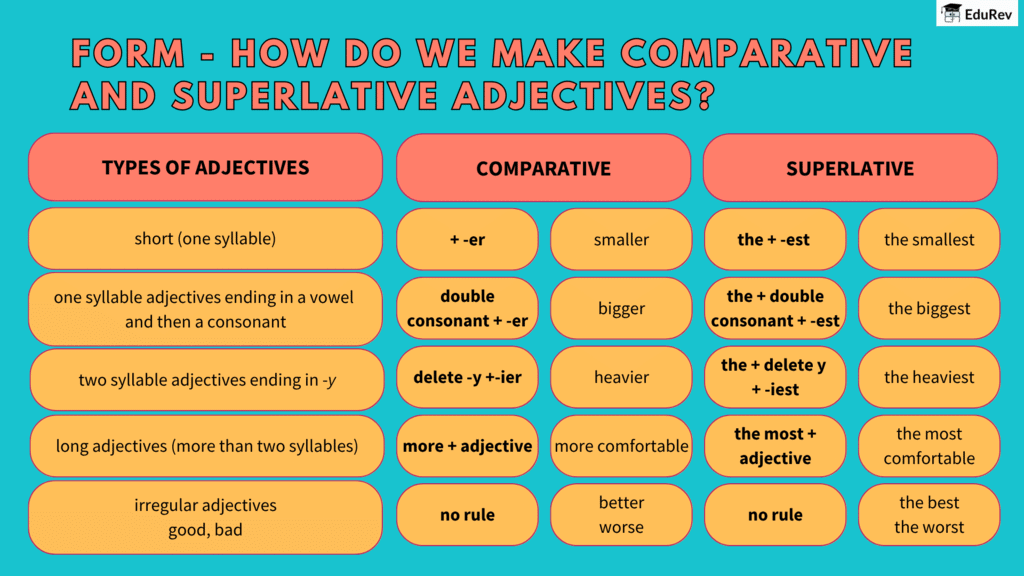Class 6 Exam > Class 6 Notes > English Grammar for Class 6 > Infographics: Degrees of Comparison
Infographics: Degrees of Comparison | English Grammar for Class 6 PDF Download

The document Infographics: Degrees of Comparison | English Grammar for Class 6 is a part of the Class 6 Course English Grammar for Class 6.
All you need of Class 6 at this link: Class 6
|
49 videos|349 docs|46 tests
|
FAQs on Infographics: Degrees of Comparison - English Grammar for Class 6
| 1. What are the degrees of comparison in English grammar? |  |
Ans. The degrees of comparison in English grammar refer to the ways in which adjectives and adverbs can indicate varying levels of quality or quantity. There are three degrees: the positive degree, which describes a quality without comparison (e.g., "tall"); the comparative degree, which compares two things (e.g., "taller"); and the superlative degree, which expresses the highest degree among three or more items (e.g., "tallest").
| 2. How do I form the comparative and superlative degrees of adjectives? |  |
Ans. To form the comparative degree, typically you add "-er" to the end of one-syllable adjectives (e.g., "small" becomes "smaller"). For adjectives with two syllables ending in "y," change the "y" to "i" and add "-er" (e.g., "happy" becomes "happier"). For the superlative degree, add "-est" to one-syllable adjectives (e.g., "small" becomes "smallest") and for two-syllable adjectives ending in "y," change the "y" to "i" and add "-est" (e.g., "happy" becomes "happiest"). For adjectives with three or more syllables, use "more" for the comparative (e.g., "more beautiful") and "most" for the superlative (e.g., "most beautiful").
| 3. Are there exceptions to the rules for forming comparatives and superlatives? |  |
Ans. Yes, there are exceptions in English. Some adjectives are irregular and do not follow the standard rules for forming comparatives and superlatives. For example, "good" becomes "better" (comparative) and "best" (superlative), while "bad" becomes "worse" (comparative) and "worst" (superlative). It's important to memorize these irregular forms as they do not follow the typical patterns.
| 4. When should I use "more" and "most" instead of "-er" and "-est"? |  |
Ans. Use "more" and "most" for adjectives with two or more syllables that do not end in "y." For example, "beautiful" becomes "more beautiful" (comparative) and "most beautiful" (superlative). This is because adjectives with two or more syllables typically do not take the "-er" or "-est" endings. Always choose the form that sounds more natural in context.
| 5. Can adverbs also have degrees of comparison? |  |
Ans. Yes, adverbs can also have degrees of comparison. Similar to adjectives, adverbs can be in the positive degree (e.g., "quickly"), the comparative degree (e.g., "more quickly"), or the superlative degree (e.g., "most quickly"). The formation follows the same rules as adjectives, where one-syllable adverbs often take "-er" and "-est," while longer adverbs use "more" and "most."
Related Searches
















